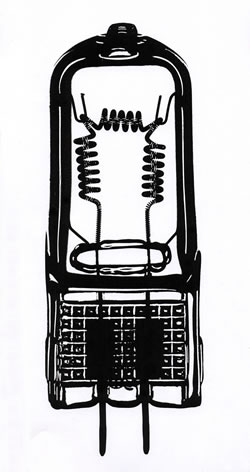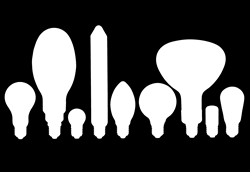The Light Bulb in My Music
Looking Back
The immediate and intense encounter of light and sound that takes place during thunderstorms and fire is one of the primal distinctive experiences of humankind. Therefore it seems likely that the interplay of sound and light is one of the first forms of multimedia expression in human culture, and that the fascination produced by this symbiosis continues undiminished into the present day. From time-honoured musical shadow plays (Figs. 1–2) on through to today’s diverse and contemporary high-tech staging — and despite the differences between all of these light and sound scenarios — one thing remains: the downright magical force of an involuntary attraction, generated by the interrelation of light and sound.


With the discovery and the utilization of electric current in the 19th and early 20th centuries, our lifestyles were confronted with radical changes, in which the invention of the light bulb and the overall general dissemination of electric light plays an essential role. Through the increased use of electric light at the beginning of the twentieth century, the urban environment received its modern, nighttime appearance. Street lanterns, shop window and entertainment lighting, the headlights of cars, light architecture and advertisement lighting spreading out from the upper storeys to the roofs all came to define the modern society of light. Thereby, the light bulb became the symbol of modernity and urban ingenuity.
Nothing more can be seen of the houses, no more ugly facades… The street is only made of light bulbs, it’s woven out of them; they are the substance of the street. (Hausenstein 1984, 9) 1[1. Wilhelm Hausenstein, Eine Stadt auf nichts gebaut… Wilhelm Hausenstein über Berlin, Architextbook, Nr. 3 (Berlin: Archibook-Verlag, 1984 [orig. 1932]).]
Besides the radical changes initiated by the light bulb in both the public and private spheres, this new rapidly spreading electric light also had a revolutionary impact on the theatre world, especially on stage lighting. Previous light technologies — for example the gas-powered static stage limelight and the highly unmanageable arc light — were no match for the new incandescent lamp embedded in a headlamp housing. With this new controllable and flexible stage lighting in the form of spotlights, theatre producers were able to use light as an active and formal element of the works, in addition to music and stage design. Whether with Edward Gordon Craig, one of the most influential innovators of the theatre and a pioneer of modern stage lighting, or at the experimental theatre stage of Adolphe Appia at the Festspielhaus in Dresden-Hellerau, or at the Deutsches Theater under Max Reinhardt in Berlin at the beginning of the 20th century, the spotlight generated by the incandescent lamp conquered the stages of the performing arts.

At the same time, the incandescent lamp provided the technical facilities to different artists using light as an independent medium in performances, installations, objects and film. Indeed, the light experiments at the beginning of the 20th century can be considered the actual basis for the use of light in contemporary art. If we look at early works, we see that time and again it has been the light bulb which has served both the technical and creative needs of the Light Art avant-garde. For example, the clavier à lumières used in Alexander Scriabin’s 1915 performance of Prometheus: The Poem of Fire projected a wide variety of coloured light onto gauze-like screens through the use of coloured light bulbs, and László Moholy-Nagy’s Light-Space Modulator (built in 1930) was also illuminated with numerous light bulbs in various colours. We could also mention the early works of Dan Flavin — who incidentally became one of the best-known light artists, with his installations of fluorescent light — such as his 1962 Icon V (Coron’s Broadway Flash), with its clear, incandescent lights framing an oil-painted “canvas” of masonite.
The Light Bulb and Me

Since the mid-1980s, I have realized a multiplicity of partly site-specific light works, most of which have included sound. In all these performances and installations, the incandescent lamp has played an essential role. With its enormous range of different finishes and forms (Fig. 4) — clear, frosted or with a bulb made out of opal glass, white or coloured, in the classic pear form or in form of a globe or a tube, as a reflector or a projection lamp, in various sizes and strength and easy to dim — this electric light source always served me well.
In my audiovisual project Light Bulb Music, an absolutely synchronized alliance of light and sound takes place. 2[2. The first public performance under the title Light Bulb Music took place in the Labor Sonor series in the Kule, Berlin on 3 January 2005.] By using different electric controllers, the filaments of various light bulbs — which function as resistors — are delivered an electric current in an irregular and unsteady way. This has an immediate effect on the temperature and thereby on the brightness of the filaments. Simultaneous to the changes in the light emittance, the resulting differences in the electromagnetic field are made audible by using various microphones and pickups connected to a mixing board (Fig. 5). On a sonic level, Light Bulb Music is a kind of microscopic listening in to the constant variations in the flow of the electrical current. The changes in light intensity, the incandescence of the filaments and the rhythmic variety of the flickering and pulsing lights are directly transformed into a comprehensive electroacoustic sound world. Through an arrangement in layers of different light bulb voices (Fig. 6), complex musical structures arise that find their visual counterpart in a vivid play of light and shadow.

In most contemporary works based on a direct conjunction of sound and light, one medium is triggered or stimulated by the other. Either light is transformed into sound or sound into light. In Light Bulb Music something completely different happens: the manipulated electric current leads to changes in light activity, while exactly the same electric current, with all its structures and changes, is scanned synchronously on a tonal level. There is no translation from one medium into the other and, in fact, the same electrical events articulate themselves visually as well as acoustically.
Light Bulb Music is the result of a very experimental working process. I conducted many tests to research the interplay of light and sound, experimented with all kinds of incandescent lamps in relation to various light-controlling devices and used many different types of microphones and pickups to “eavesdrop” into the acoustic potential of the various light events I was creating. In this process, the light bulb itself proved to be highly susceptible to all kinds of subtle electrical manipulations, and its filament showed how flexible and extremely sensitive it was, even to very fine changes in the electrical current.

Due to the use of only entirely analogue light controllers, the electric power supply often shifts the light bulb’s filament into an intermediate range, somewhere between being switched on or off. This leads to particularly tonal, extremely surprising and interesting results. For example, in the cases of a slow discharge voltage, an irregular voltage feed, an extremely dense sequence of light bulbs switched on and off (which evokes fast changes of inrush and nominal current), as well as through various other kinds of treatment of the electrical flow, I receive a fascinating palette of sounds.
Of course such a method of operation leads to results which are rather less controlled by a traditional musical procedure than by the sounds themselves, which are generated by the given setting. The attempt to form a musical structure rises out of the sound material itself.

In my installations as well as in my performances with light I always preferred to use materials and technical equipment that were simple and would remain comprehensible for an audience. I wanted my work with electric light to be transparent and technically understandable for the viewer, and the use of simple light bulbs and a basic control technique — as in my project Light Bulb Music — seemed to fit perfectly with this idea of avoiding the inscrutable technical complexities that are so often associated with modern media art.
With the light bulb, a source of light is at my disposal that is — or was — available in a huge variety, consisting of a large spectrum of various light qualities that are at the same time handy and technically easy to use. 3[3. Although one should certainly note that an incandescent lamp is an extremely advanced industrial product and that the mystery of electricity is not at all easy to understand.]
But now, through new regulations and prohibitions, the once-ubiquitous incandescent light bulb has become a threatened species — not only in the European community but also worldwide. Thereby, a source of light that just a short time ago had been a mass-produced object suddenly receives, on the one hand, a nostalgic character and, on the other, a reappraisal. It is given special attention, not unlike that which it received at the beginning of its more than 130-year history.
Often I am asked if the Light Bulb Music projectis now in danger of being a victim of the ban on the incandescent lamp. No worries, as I have been stockpiling them and therefore my light bulbs will keep shining and sounding for quite a while.
Social top